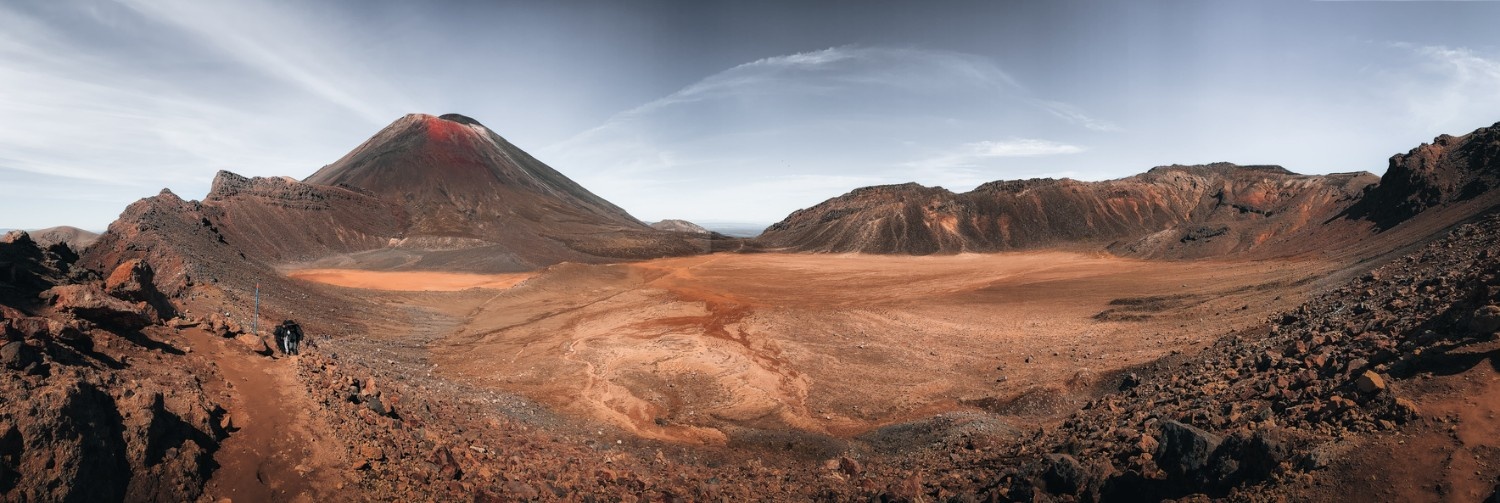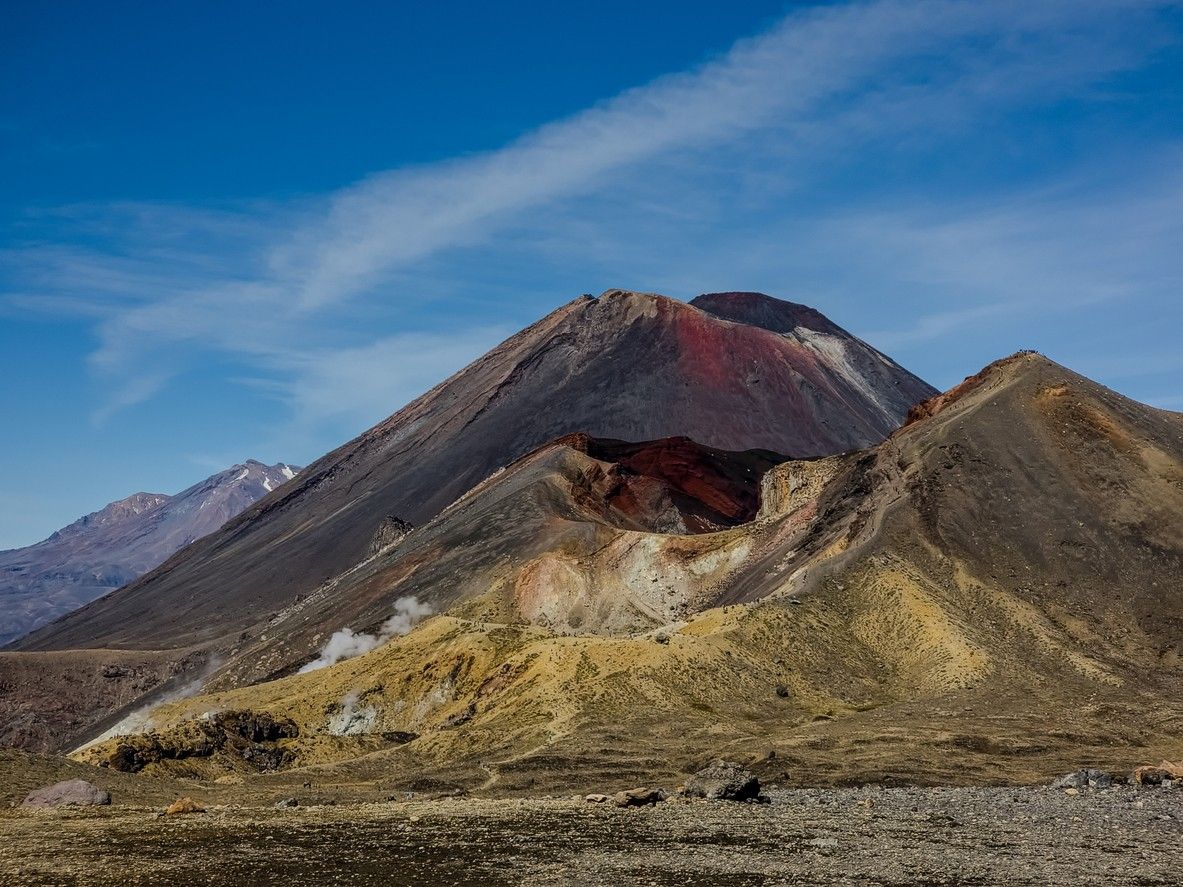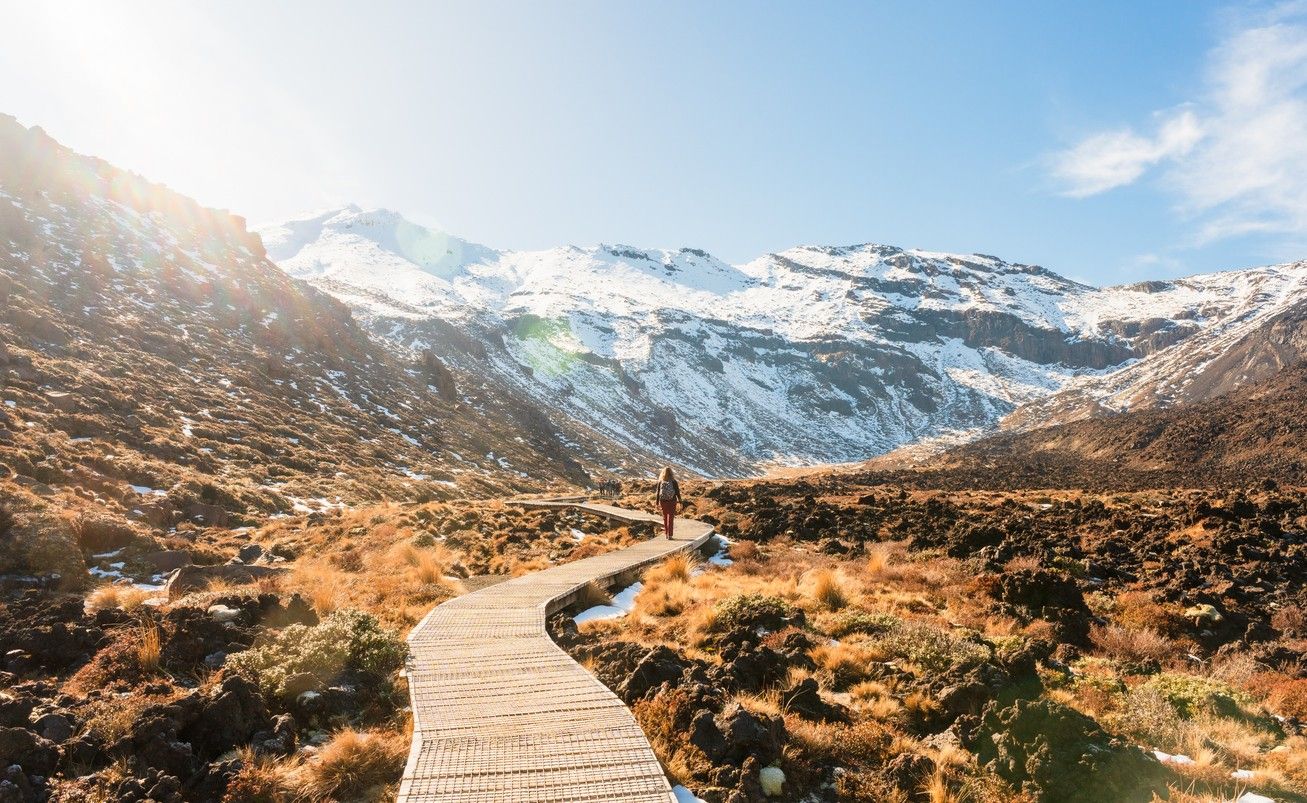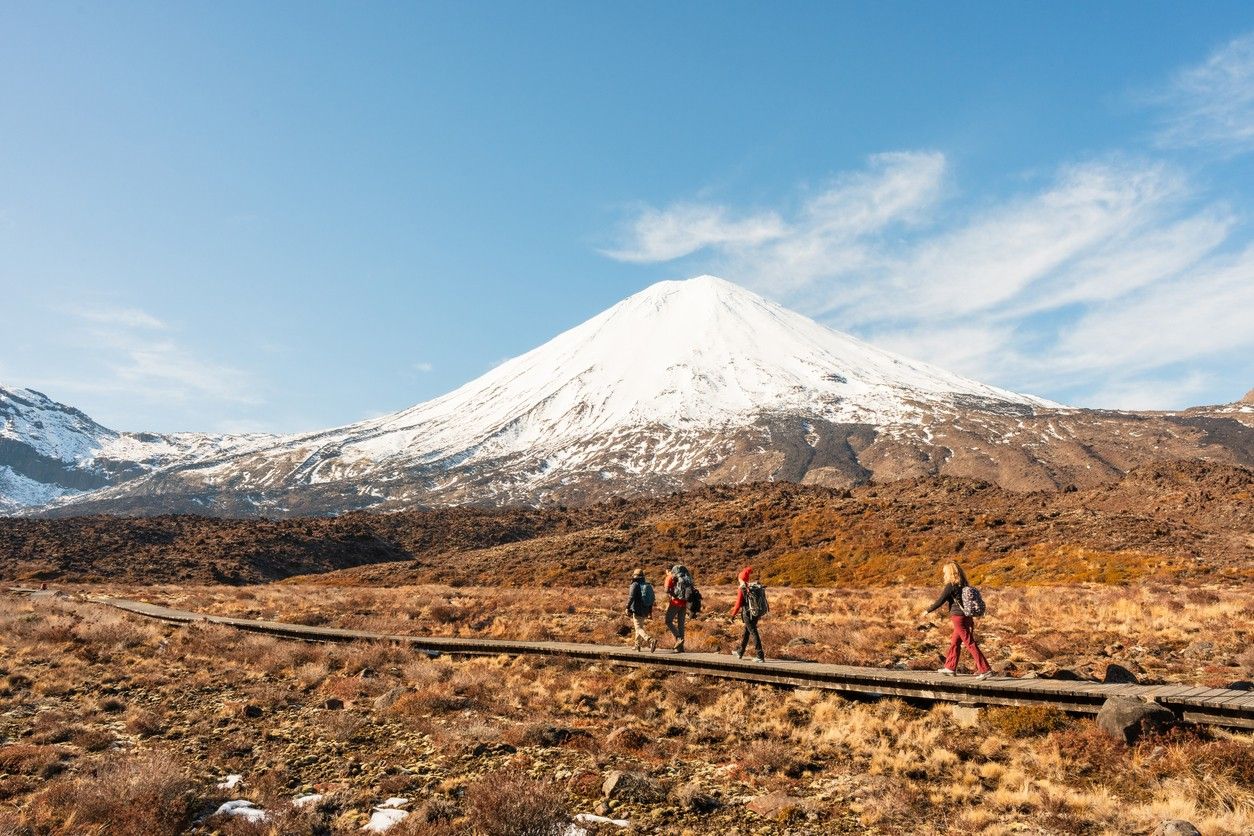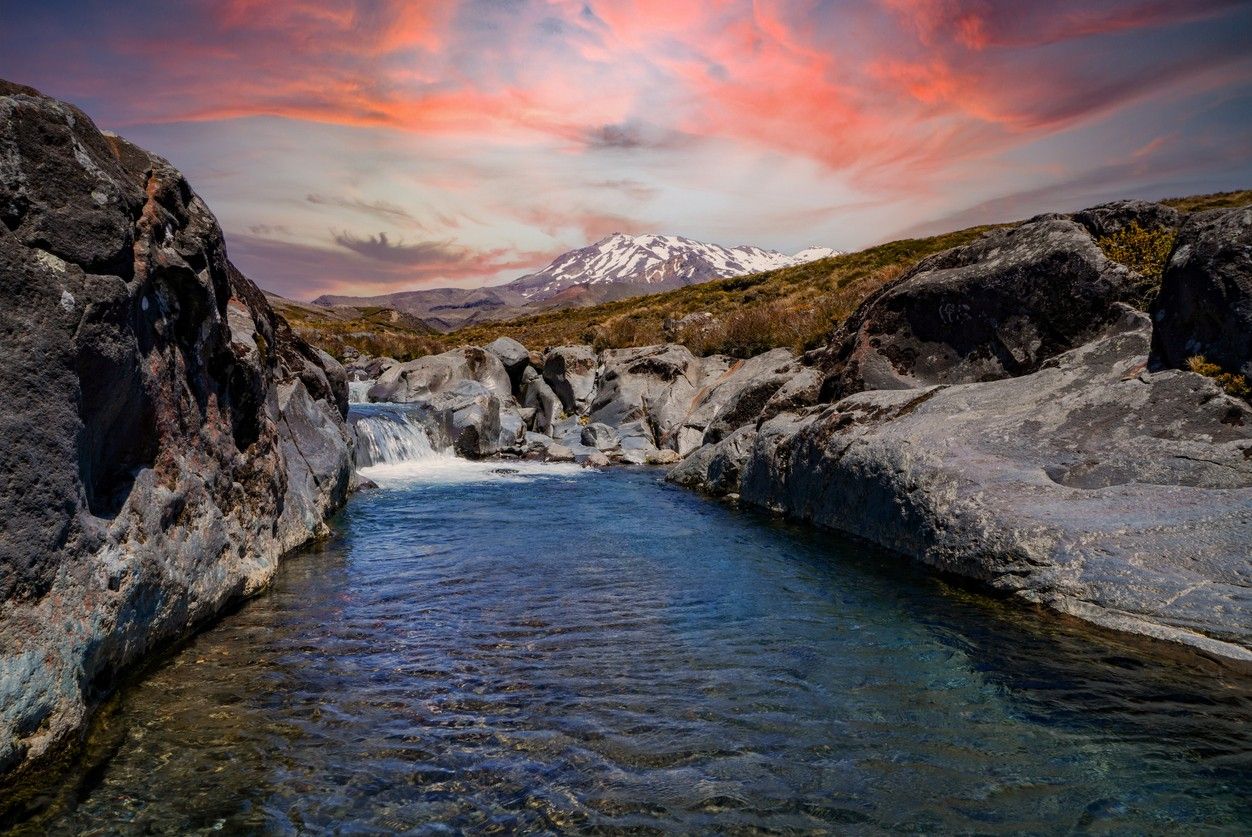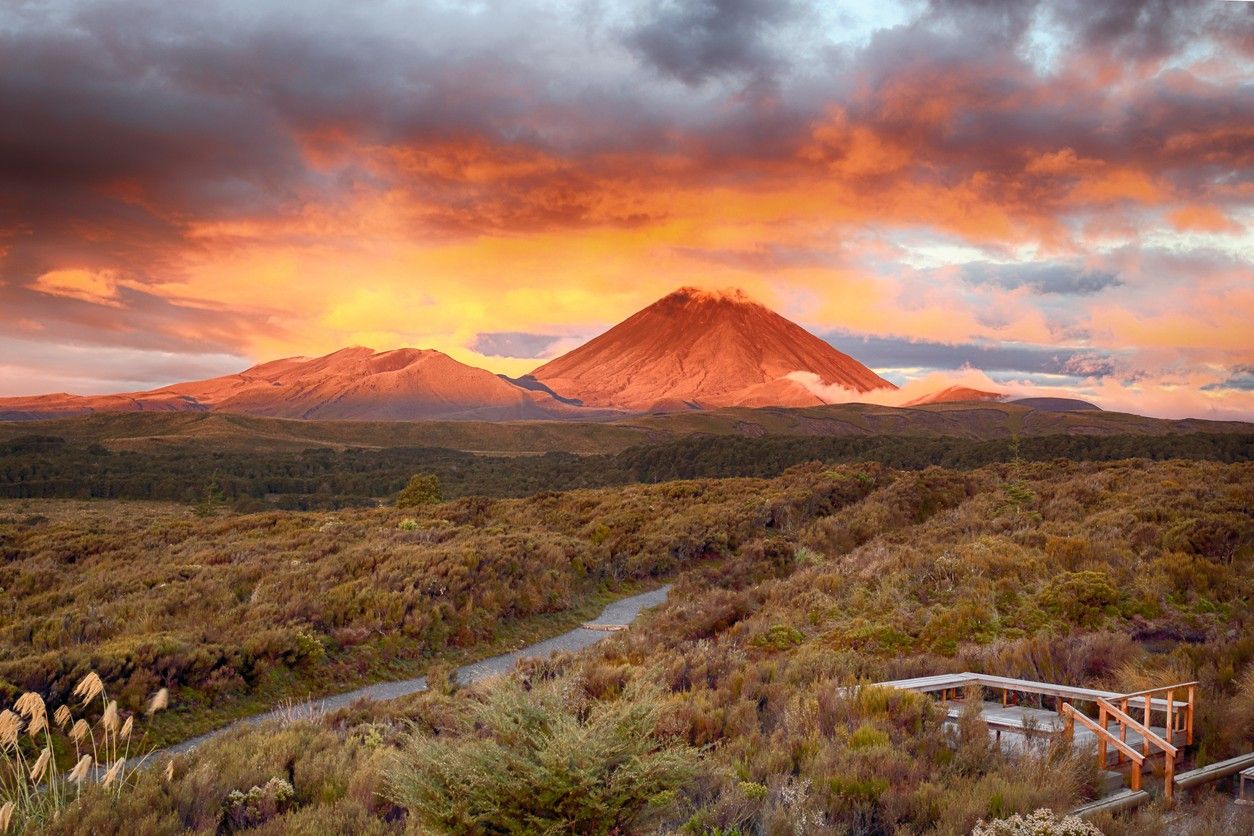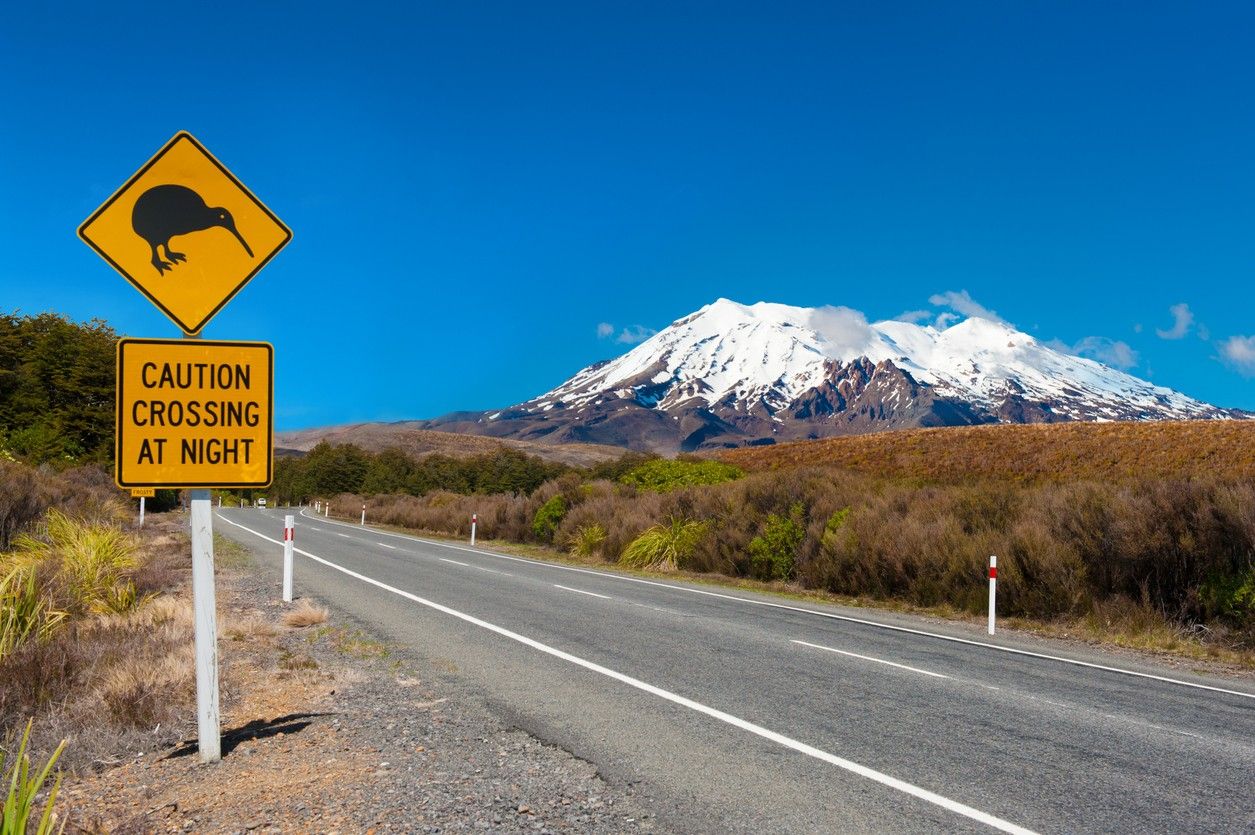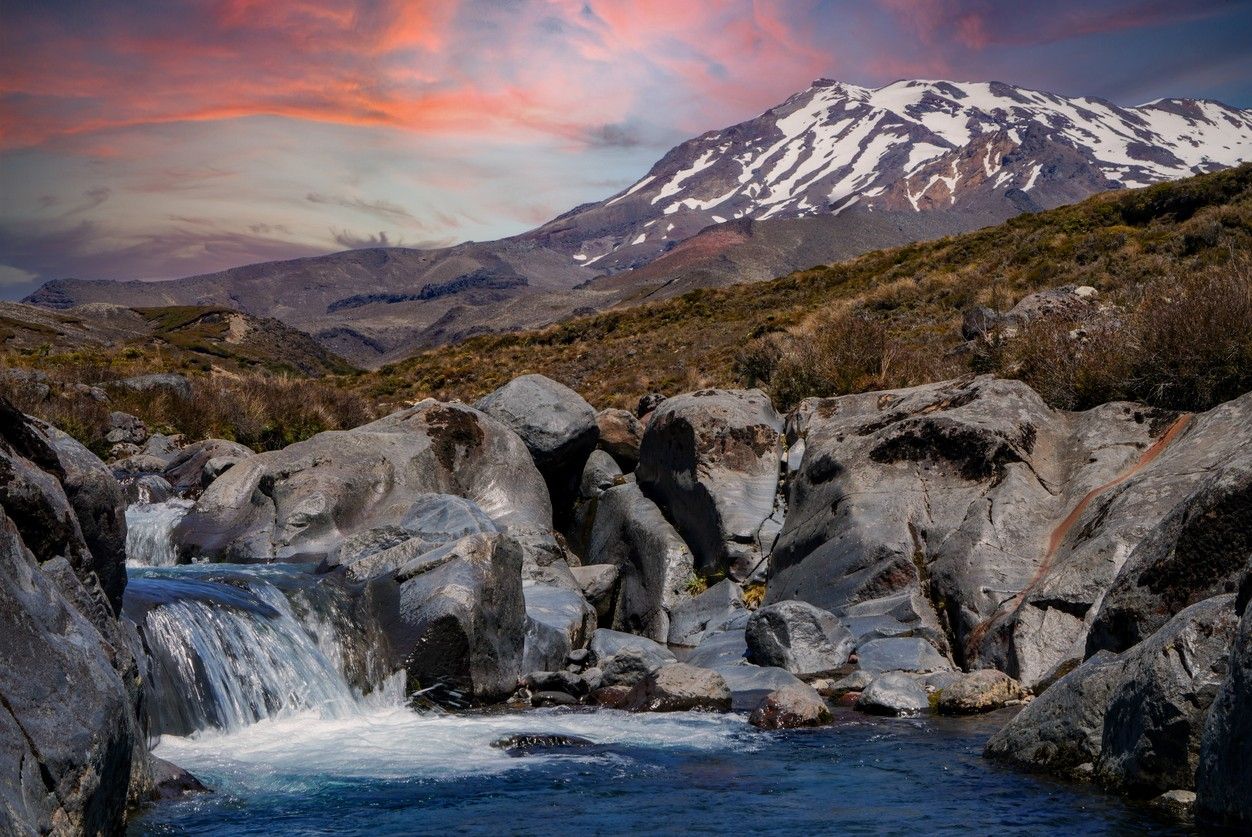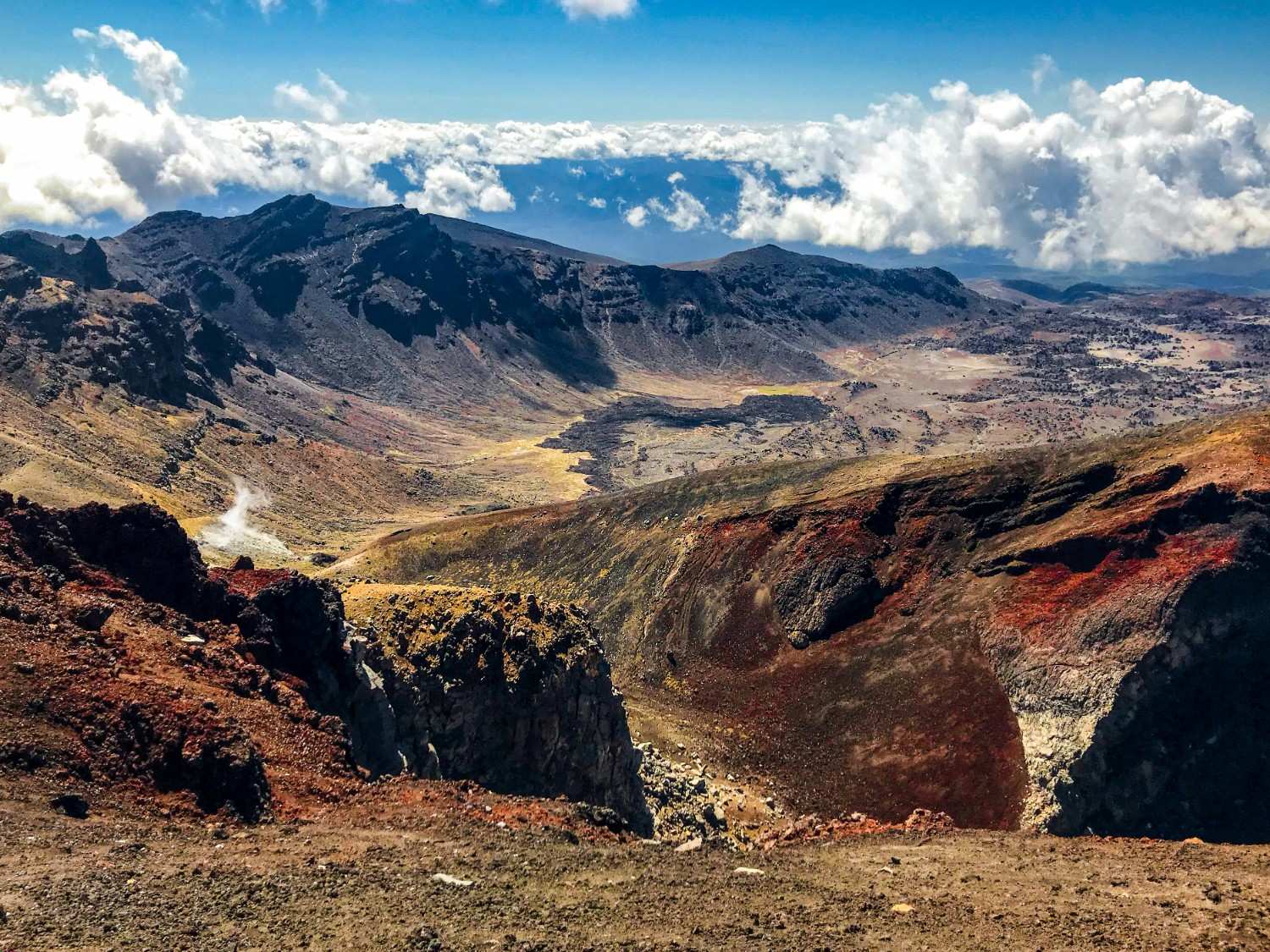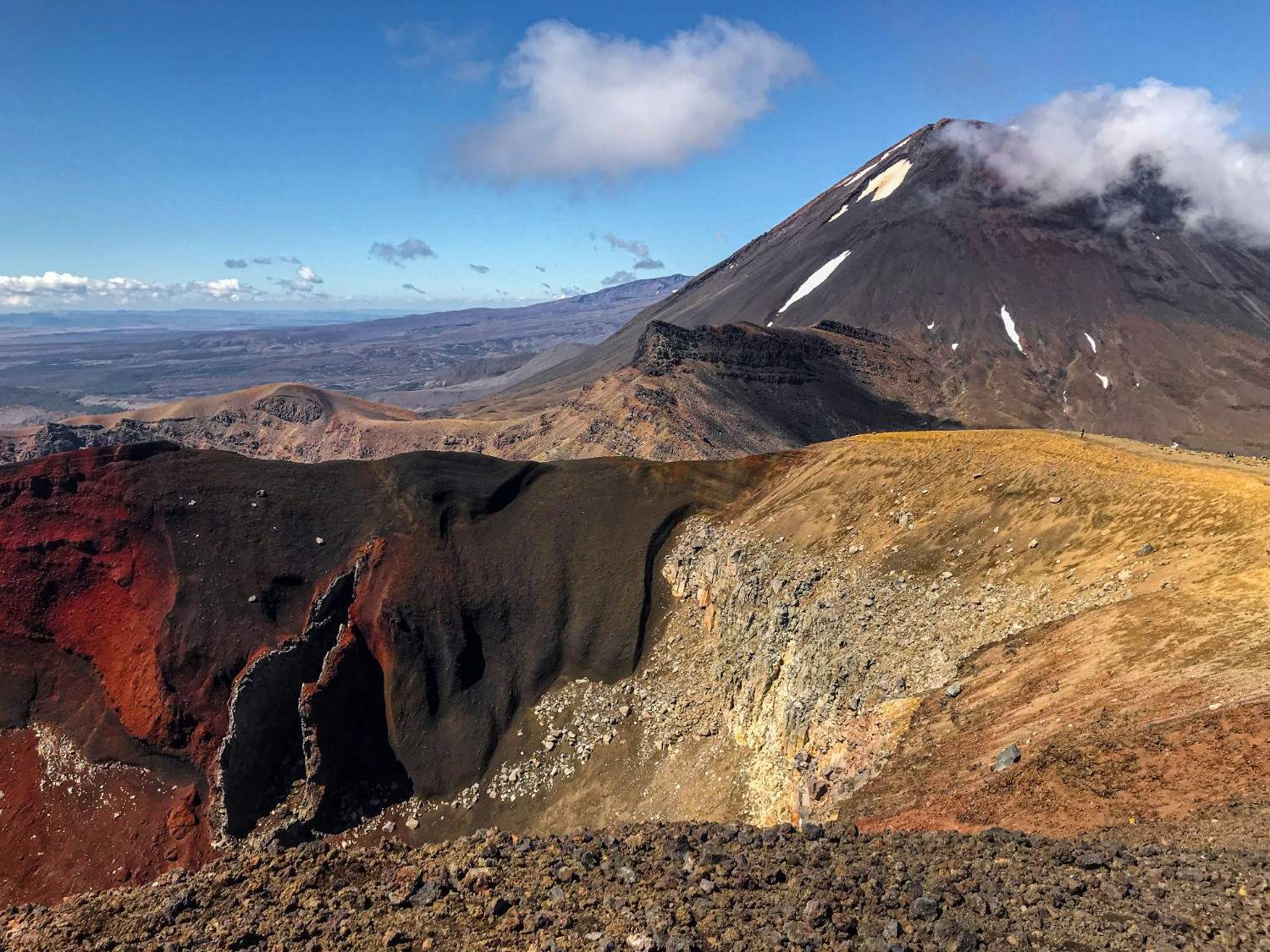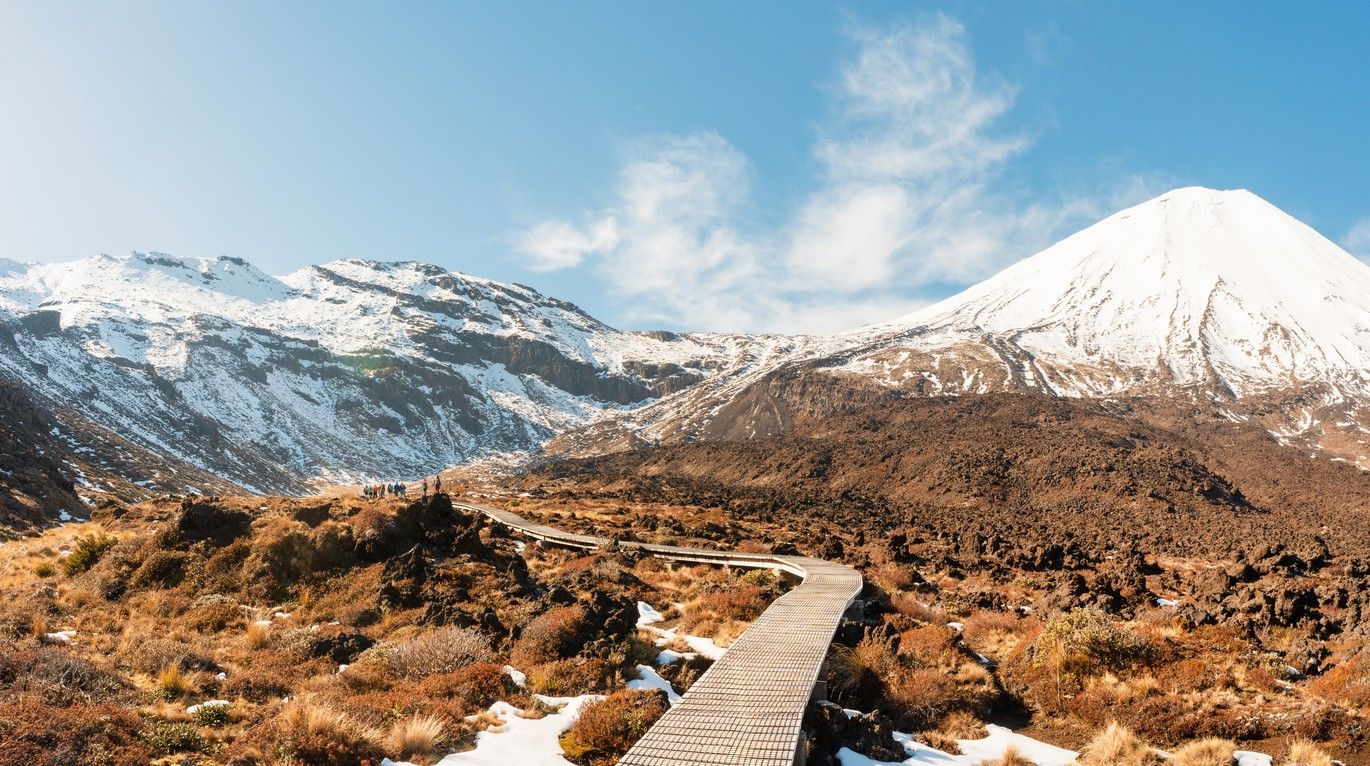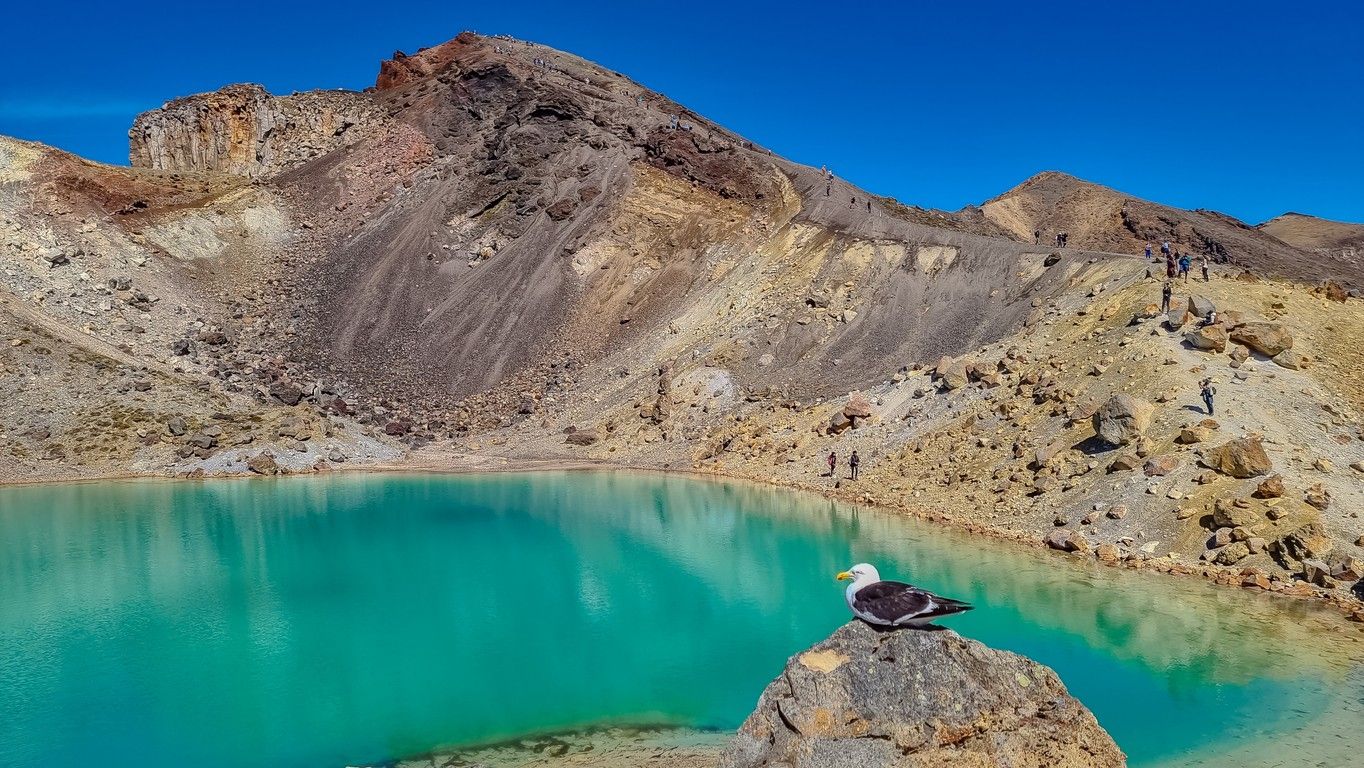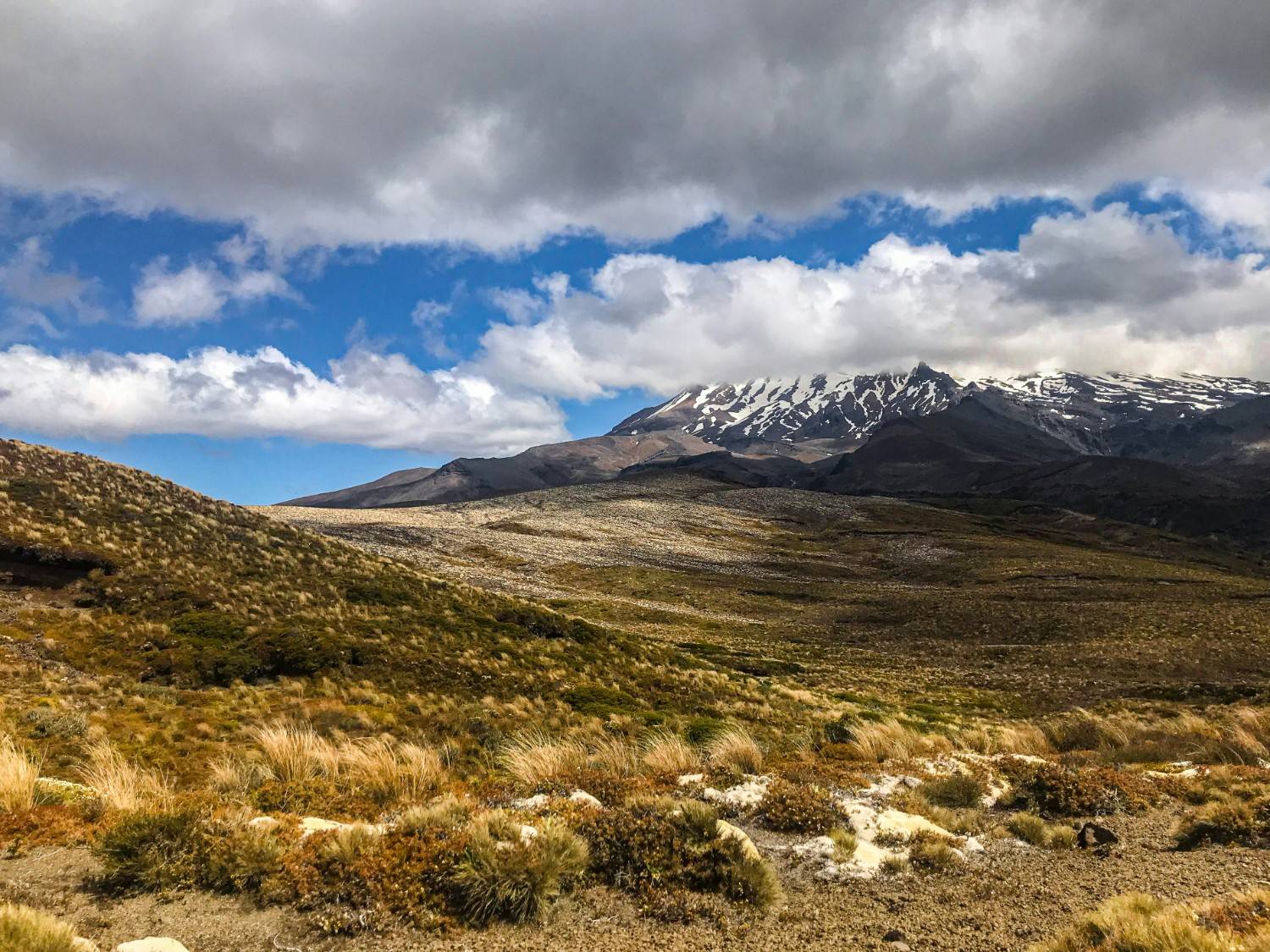Tongariro National Park is a breathtakingly beautiful region situated in the central North Island of New Zealand. Established in 1887, it boasts the distinguished title of being New Zealand's oldest national park, a testament to its enduring allure and significance. However, Tongariro's accolades extend far beyond its age, as it holds the prestigious dual status of a UNESCO World Heritage Site, recognised for both its outstanding natural beauty and its profound cultural importance to the Māori people. This remarkable expanse of wilderness encompasses three striking volcanic peaks that dominate the landscape – Tongariro, Ngauruhoe, and Ruapehu. Each of these towering mountains is a geological marvel in its own right, from the multi-cratered massif of Mount Tongariro to the perfectly symmetrical cone of Mount Ngauruhoe, famously depicted as Mount Doom in the Lord of the Rings films. The highest of the three, Mount Ruapehu, stands tall at 2,797 meters (9,177 feet), its glaciated summit and turquoise Crater Lake serving as iconic landmarks visible for miles around.
But Tongariro National Park is far more than just its volcanic peaks. This extraordinary region boasts an array of diverse landscapes that will leave visitors in awe at every turn. Alpine meadows carpeted with vibrant wildflowers give way to pristine emerald lakes formed by glacial meltwater, their brilliant hues changing with the light and mineral content. Ancient lava flows and rugged scoria fields provide a stark contrast to the lush native forests teeming with birdlife. Perhaps most mesmerising of all are the park's vibrant geothermal areas, where bubbling mud pools, steaming vents, and silica terraces painted in every shade of the rainbow offer a glimpse into the raw power of the Earth's interior forces. It is a landscape that seems almost otherworldly, a testament to the incredible geological forces that have shaped this region over millennia.
Unravelling the Volcanic Majesty — The Three Peaks of Tongariro
One of the most iconic features of Tongariro National Park is its three towering volcanic peaks, each with its unique character and allure. Let's delve into the grandeur of these geological marvels.
Mount Tongariro
The massive Mount Tongariro, the park's namesake peak, is a complex volcano that dominates the landscape with its multiple craters, vents, and distinctive red-orange hues caused by oxidised iron in the rock. Situated in the heart of Tongariro National Park, this 1,967-metre (6,453-foot) volcanic giant spans an incredible 20 kilometres (12.4 miles) in diameter, making it one of the largest and most complex volcanic systems in New Zealand's Taupo Volcanic Zone. Mount Tongariro's last major eruption occurred in 2012, a powerful reminder of the forces that continue to shape this remarkable landscape. The Tongariro Alpine Crossing, often hailed as one of the world's best day hikes, traverses the heart of this volcanic massif, offering hikers an up-close encounter with the park's diverse geological features. The trail ascends to the Red Crater, a surreal landscape where the oxidised iron in the rock paints the surroundings in vivid shades of red and orange. Along the way, you'll have the opportunity to witness other unique geological features, such as the Soda Springs, where bubbling mineral waters emerge from the earth, and the Blue Lake, a vivid azure-hued body of water nestled in the volcanic terrain. The sheer scale and diversity of Mount Tongariro's volcanic features are truly awe-inspiring, making it a must-visit destination for anyone seeking to understand the power and majesty of New Zealand's volcanic heritage.
Mount Ngauruhoe
Situated just south of Mount Tongariro, the perfectly formed stratovolcano of Mount Ngauruhoe stands at an elevation of 2,291 metres (7,515 feet), its symmetrical cone and distinctive glacial features making it one of the most iconic and recognisable peaks in New Zealand. Famously portrayed as Mount Doom in Peter Jackson's "The Lord of the Rings" trilogy, Ngauruhoe has become a symbol of the country's rugged beauty, capturing the imagination of hikers and movie fans alike. Ngauruhoe's last major eruption occurred in 1975, when a series of spectacular lava flows and ash emissions painted the mountain in shades of fiery red and orange, creating a mesmerising display of nature's raw power. Despite its active volcanic status, which prohibits summit attempts, the Tongariro Alpine Crossing offers numerous vantage points from which hikers can marvel at Ngauruhoe's perfect conical shape and appreciate its geological significance as part of the Tongariro Volcanic Plateau. As you approach the saddle between Mount Tongariro and Mount Ngauruhoe, the imposing presence of Ngauruhoe becomes increasingly apparent. Its steep, symmetrical slopes rise dramatically from the surrounding terrain, its snow-capped peak a stark contrast against the volcanic landscape. The sight of this majestic peak is sure to leave you in awe, inspiring a deep respect for the powerful forces that have shaped this natural wonder.
Mount Ruapehu
Standing tall as the highest peak in the Tongariro National Park and the entire North Island, Mount Ruapehu is a towering stratovolcano that commands respect and awe. With an elevation of 2,797 metres (9,175 feet), this massive peak is located approximately 40 kilometres (25 miles) southwest of Mount Tongariro and Ngauruhoe and is a significant part of the Tongariro Volcanic Plateau. One of Ruapehu's most iconic features is the Crater Lake, a stunning turquoise-hued body of water that fills the volcano's crater at an elevation of 2,200 metres (7,200 feet). This vibrant lake, formed from melted snow and rainwater, is a true natural wonder, drawing visitors from far and wide to witness its unique beauty and ever-changing hues that range from deep blue to vibrant turquoise, depending on the mineral content and weather conditions. In addition to its geological significance, Mount Ruapehu is also a premier destination for winter sports enthusiasts. The mountain boasts two ski fields – Whakapapa and Turoa – that offer world-class skiing and snowboarding opportunities amid breathtaking alpine landscapes. With its glaciers, snowfields, and steep slopes, Ruapehu provides a challenging and exhilarating experience for winter sports enthusiasts of all skill levels. Despite its towering stature and snowy peak, Mount Ruapehu is considered one of the world's most active volcanoes, with frequent minor eruptions and significant events occurring every few decades. The most recent major eruption took place in 1995-1996, a powerful reminder of the forces that continue to shape this remarkable volcanic landscape.
Hiking Adventures in Tongariro — Conquering the Tongariro Alpine Crossing
No visit to Tongariro National Park would be complete without embarking on the iconic Tongariro Alpine Crossing, a 19.4-kilometre (12.1-mile) hiking trail that winds through some of the park's most spectacular scenery. This renowned day hike is often lauded as one of the finest in New Zealand, if not the world, and promises an unforgettable journey through a volcanic wonderland. The Tongariro Alpine Crossing begins at the Mangatepopo Valley and ascends to the saddle between Mount Tongariro and Mount Ngauruhoe, offering panoramic vistas of the volcanic peaks and the vibrant Emerald Lakes. From there, the trail continues across the South Crater, a stark lunar-like landscape dotted with volcanic rocks and steaming vents. As you traverse the aptly named Red Crater, the vibrant hues of the oxidised iron in the rock will leave you awestruck.
Along the way, you'll encounter a range of unique geological features, such as the Soda Springs, where bubbling mineral waters emerge from the earth, and the Blue Lake, a vivid azure-hued body of water nestled in the volcanic terrain. The trail culminates at the Ketetahi Shelter, where you can bask in the sense of achievement and take in the stunning vistas one last time before descending. While the Tongariro Alpine Crossing is considered a challenging hike, its well-maintained trails and incredible scenery make it a must-do for anyone seeking an unforgettable outdoor adventure in New Zealand. In addition to the renowned Tongariro Alpine Crossing, Tongariro National Park offers a diverse range of hiking trails that cater to various skill levels and interests. Here are some of the other notable trails within the park:
Taranaki Falls Loop Track (6 km, 2-3 hours) — This easy loop trail leads to the spectacular Taranaki Falls, one of the park's most beautiful waterfalls, located near Whakapapa Village.
Silica Rapids Track (3 km return, 1-2 hours) — Starting from the Silica Rapids car park, this short hike takes you to the Silica Rapids and Ohinepango Springs, showcasing the park's geothermal wonders.
Tama Lakes Track (17 km return, 6-8 hours) — This challenging but rewarding hike leads to the pristine Tama Lakes, a series of alpine lakes nestled in the heart of the park, offering stunning views of Mount Ngauruhoe and Mount Ruapehu.
Ohakune Old Coach Road (14.5 km one way) — Part of the historic Coach Road that once connected Ohakune to Horopito, this trail offers a glimpse into the region's past while traversing through native bush and volcanic landscapes.
Mangawhero Forest Walk (3.5 km loop, 1-2 hours) — For those seeking a respite from the volcanic landscapes, this easy loop trail winds through the lush Mangawhero Forest, showcasing the park's diverse flora and fauna.
Mount Ruapehu Crater Rim Walk (8 km, 4-6 hours) — This challenging hike circumnavigates the crater rim of Mount Ruapehu, offering breathtaking views of the Crater Lake and the surrounding volcanic peaks.
With such a diverse range of trails catering to various abilities and interests, Tongariro National Park offers endless opportunities for hikers to immerse themselves in the park's natural wonders and explore its unique volcanic landscapes.
Exploring the Diverse Landscapes — Beyond the Volcanic Peaks
While the volcanic peaks are undoubtedly the stars of the show, Tongariro National Park offers a wealth of diverse landscapes and natural wonders to explore. From pristine alpine meadows and crystal-clear lakes to ancient lava flows and geothermal areas, this park is a true haven for nature lovers.
Tama Lakes
Nestled in the heart of Tongariro National Park, the Tama Lakes are a series of pristine alpine lakes that offer a serene escape from the volcanic landscapes. These lakes, formed by glacial meltwater, are renowned for their vibrant emerald and turquoise hues, which change depending on the mineral content and the angle of the sun. To reach the Tama Lakes, hikers can embark on the challenging but rewarding Tama Lakes Track, a 17-kilometre (10.6-mile) return hike that starts from the Whakapapa Village area. The trail ascends through native beech forests and alpine meadows, offering stunning views of Mount Ngauruhoe and Mount Ruapehu along the way. Upon arriving at the Tama Lakes, visitors are greeted by a breathtaking sight – a series of pristine lakes nestled in a glacial valley, surrounded by towering volcanic peaks. The Lower Tama Lake is the largest and most accessible, while the Upper Tama Lake is a bit more challenging to reach but offers even more stunning vistas. Hiking trails wind around the lakes, allowing visitors to explore the area at their own pace and admire the incredible natural beauty. Keep an eye out for native birdlife, such as the cheeky fantail and the majestic kereru (wood pigeon), as well as unique alpine flora that thrives in this harsh yet beautiful environment.
Silica Rapids and Ohinepango Springs
For a glimpse into the geothermal wonders of Tongariro National Park, the Silica Rapids and Ohinepango Springs are a must-visit destination. Located near the Whakapapa Village area, these natural attractions are easily accessible via the Silica Rapids Track, a 3-kilometre (1.9-mile) return hike. The silica-rich waters have formed these unique terraces over thousands of years, resulting in a stunning visual spectacle that changes with the light and weather conditions. Just a short distance away, the Ohinepango Springs offers another geothermal marvel. Here, you'll witness bubbling mud pools, steaming vents, and hot springs, all testament to the volcanic activity that shapes this remarkable landscape. The area is also home to a variety of thermophilic plants and microorganisms that thrive in these extreme conditions, adding to the unique character of this geothermal wonderland.
Mangawhero Forest
For those seeking a respite from the volcanic landscapes, the Mangawhero Forest offers a lush and verdant oasis within Tongariro National Park. This ancient forest, located near Ohakune, is home to a diverse array of native plant life, including towering rimu and totara trees, as well as a variety of ferns, mosses, and epiphytes. The Mangawhero Forest Walk is a 3.5-kilometre (2.2-mile) loop trail that winds through the heart of this pristine forest, offering a tranquil escape and an opportunity to appreciate the park's rich biodiversity. Keep an eye out for the iconic native birds that call this forest home, such as the melodious tui and the inquisitive fantail. The forest floor is carpeted with a vibrant array of mosses and ferns, creating a lush and verdant oasis that contrasts with the stark volcanic landscapes found elsewhere in the park. In addition to its natural beauty, the Mangawhero Forest Walk also offers glimpses into the region's history, with remnants of old logging tracks and sawmill sites serving as reminders of the area's past industries.
Discovering Tongariro's Unique Flora and Fauna
Tongariro National Park is not only a geological marvel but also a haven for a diverse array of flora and fauna. From the iconic kiwi bird to the vibrant wildflowers that carpet the alpine meadows, this park offers countless opportunities to witness and appreciate New Zealand's unique natural heritage.
Native Birds
Tongariro National Park is a veritable paradise for birdwatchers and nature enthusiasts, offering the opportunity to witness some of New Zealand's most iconic and rare avian species in their natural habitats. One of the most sought-after and elusive birds in the park is the kiwi, the flightless national symbol of New Zealand. These nocturnal creatures, with their distinct call and long, slender beaks, can be spotted during guided night tours or by exploring the park's trails at dusk or dawn when they are most active. A highlight for many visitors is the melodious tui, a striking bird with iridescent black plumage adorned with a white tuft on its throat. Known for its distinctive, multi-pitched call and energetic antics as it flits from tree to tree, the tui is a common sight in the forested areas of the park, particularly around blooming native plants whose nectar they feed on. The cheeky and inquisitive fantail, with its distinctive fanned tail and acrobatic movements, is also a familiar presence, often observed flitting around hikers in search of insects stirred up by their footsteps.
The majestic kereru, or wood pigeon, is another iconic species that can be spotted in Tongariro National Park. With its vibrant green and purple plumage, distinctive wing beats, and bulky frame, this large pigeon is a captivating sight as it soars overhead or forages in the treetops. Visitors may also be treated to the sight of the rare and endangered North Island kokako, a bluish-grey bird with a striking black mask and wattle, whose haunting calls echo through the ancient forests. Other notable birds found in the park include the North Island robin, a friendly and inquisitive bird that will often approach hikers; the tomtit, a small and acrobatic bird with a distinctive high-pitched call; and various species of parakeets, shags, and native ducks. Birdwatchers can also keep an eye out for the majestic New Zealand falcon, one of the country's most iconic birds of prey, as it soars over the volcanic landscapes in search of its next meal.
Native Plants
Tongariro National Park is a true botanical wonderland, showcasing a rich tapestry of native plant life that ranges from hardy alpine species to lush forest vegetation. In the park's higher elevations, visitors can marvel at the vibrant wildflowers that carpet the alpine meadows, such as the iconic Mount Cook lily. With its striking white petals and golden centre, this beautiful flower is a true showstopper, blooming in the summer months and adding a splash of colour to the rugged volcanic terrain. Hardy shrubs and grasses, adapted to the harsh conditions of the alpine environment, add to the diverse array of flora found at these elevations. Plants like the mountain daisies, with their cheerful yellow blooms, and the prickly spaniard, a spiky plant with tall, slender spikes, dot the landscape, showcasing the resilience of nature in this unforgiving environment.
As you descend into the lower elevations, the park's native forests reveal a verdant world of towering rimu and totara trees, providing shelter for a diverse array of ferns, mosses, and epiphytes. The lush understory is home to a variety of unique plant species, including the striking red and green fronds of the wheki (tree fern) and the delicate tendrils of the native jasmine. The iconic silver fern, a national symbol of New Zealand, can also be found in these forests, its distinctive fronds adding to the natural beauty of the surroundings. In the geothermal areas, visitors can witness the remarkable resilience of thermophilic plants, such as the bright green and yellow mosses and algae that thrive in the hot, mineral-rich waters. These hardy organisms add splashes of colour to the otherworldly landscapes of bubbling mud pools and steaming vents, creating a surreal and captivating scene that showcases the incredible adaptability of life in even the most extreme environments.
Cultural Significance — Exploring the Rich Heritage of Tongariro
Tongariro National Park holds immense cultural significance for the Māori people, the indigenous inhabitants of New Zealand. The park's volcanic peaks, lakes, and landscapes are steeped in ancient traditions and legends, making it a sacred and revered place for the local communities.
Māori Legends and Traditions
Tongariro National Park holds immense cultural significance for the Māori people, the indigenous inhabitants of New Zealand. According to Māori mythology, the three volcanic peaks of Tongariro, Ngauruhoe, and Ruapehu are the embodiment of powerful ancestors and spiritual guardians. The legends tell of the epic journey of the demigod Ngatoroirangi, who travelled from the ancient homeland of Hawaiki to New Zealand. Upon arriving, he attempted to climb the sacred mountains to carry the sacred fires of his homeland to the new land. However, the icy winds and storms proved too fierce, and he sought the assistance of his ancestors, represented by the three peaks. Mount Tongariro is believed to be the embodiment of Ngatoroirangi himself, while Mount Ngauruhoe represents the sacred fire he carried from Hawaiki. Mount Ruapehu is said to be the personification of Ngatoroirangi's rival, who tried to extinguish the sacred fire with his icy breath. These sacred mountains are revered by the Māori as taonga (treasures) and play a central role in their cultural identity and spiritual beliefs. The legends and traditions surrounding the peaks have been passed down through generations, ensuring that the deep connection between the Māori people and this volcanic landscape remains strong.
Dual World Heritage Status
In recognition of its outstanding natural and cultural values, Tongariro National Park was inscribed as a dual World Heritage Site by UNESCO in 1990 and 1993, respectively. This prestigious designation highlights the park's significance not only as a natural wonder but also as a place of immense cultural importance for the Māori people. The natural World Heritage status was awarded due to the park's exceptional volcanic features, including the three iconic peaks, as well as its diverse landscapes and ecosystems. The park showcases a remarkable array of geological phenomena, from active volcanoes and glaciers to pristine lakes and ancient lava flows, making it a truly unique and valuable natural asset. The cultural World Heritage status, on the other hand, acknowledges the deep spiritual and cultural connections between the Māori people and the park's volcanic landscapes. The sacred mountains and their associated legends and traditions are an integral part of Māori identity and have been celebrated and preserved for generations.
Māori Guided Tours
To fully appreciate the cultural significance of Tongariro National Park, it is highly recommended to embark on a guided tour led by knowledgeable Māori guides. These passionate individuals offer an invaluable opportunity to gain a deeper understanding of the rich heritage and traditions associated with this sacred land, providing insights that would be difficult to obtain through self-guided exploration. During a Māori guided tour, visitors can expect to hear first-hand accounts of the legends and stories surrounding the volcanic peaks, as well as insights into the Māori worldview and their deep connection to the natural environment. The guides will share traditional knowledge and practices, such as the use of native plants for medicinal and cultural purposes, and explain the significance of various landmarks and features within the park.
One of the highlights of these tours is the opportunity to witness and participate in traditional Māori cultural practices. Guides may lead visitors in karakia (prayers and incantations) to acknowledge the spiritual significance of certain sites or share waiata (songs) and haka (ceremonial dances) that have been passed down through generations. These cultural experiences offer a profound connection to the living heritage of the Māori people and provide a deeper appreciation for the reverence they hold for the natural world. Many Māori guided tours also incorporate visits to significant cultural sites within the park, such as ancient rock carvings, traditional pa (fortified villages), and sacred burial grounds. These sites offer a tangible link to the rich history of the Māori people and their enduring relationship with the land. By participating in these tours, visitors not only gain a deeper appreciation for the cultural richness of Tongariro National Park but also contribute to the preservation and promotion of Māori traditions. The knowledge and insights shared by the guides help to foster greater understanding and respect for the indigenous people's unique worldview and their role as kaitiaki (guardians) of this sacred landscape.
Finding the Perfect Base for Your Tongariro Adventure
Whether you're planning a day trip or a multi-day exploration of Tongariro National Park, finding the right accommodation can greatly enhance your overall experience. From cosy lodges nestled in the heart of the park to charming villages nearby, there are options to suit every preference and budget.
Whakapapa Village
Nestled within the boundaries of Tongariro National Park, Whakapapa Village is the perfect base for those seeking convenient access to the park's attractions and a truly immersive experience in the heart of this volcanic wonderland. This quaint alpine village, surrounded by breathtaking volcanic landscapes and towering peaks, offers a range of accommodation options to suit various preferences and budgets. The iconic Chateau Tongariro, a grand hotel with a rich history dating back to the early 20th century, is the crown jewel of Whakapapa Village's accommodation offerings. This iconic establishment boasts stunning views of Mount Ruapehu and the surrounding landscapes, making it an ideal retreat for those seeking luxury and comfort amidst nature's splendour. With its elegant décor, top-notch amenities, and prime location, the Chateau Tongariro offers a truly unforgettable stay in the heart of the national park. In addition to the historic Chateau, Whakapapa Village offers a variety of other accommodation options, including cosy lodges, modern motels, and well-equipped holiday parks. Many of these establishments are family-owned and operated, providing a warm and welcoming atmosphere that adds to the charm of this alpine village. From rustic cabins nestled in the native bush to contemporary apartments with all the amenities, there is something to suit every traveller's needs and preferences. One of the key advantages of staying in Whakapapa Village is the convenient access it provides to the park's hiking trails, including the famous Tongariro Alpine Crossing. Visitors can step out of their accommodation and embark on a world-class hiking adventure, surrounded by the stunning volcanic landscapes that make this park so iconic. Additionally, the village is home to several restaurants, cafes, and shops, ensuring that visitors have everything they need for a comfortable and enjoyable stay without having to venture too far from their base.
Ohakune
Just a short drive from the park's entrance, the charming town of Ohakune is a popular choice for accommodation when visiting Tongariro National Park. This vibrant alpine village offers a variety of hotels, motels, and holiday homes, catering to various budgets and preferences, while also providing a lively atmosphere and a range of amenities for visitors. Ohakune's location, nestled in the foothills of Mount Ruapehu, provides visitors with easy access to the park's attractions while also offering a more bustling environment compared to the quieter villages within the park boundaries. The town's main street is lined with cafes, restaurants, bars, and shops, creating a lively ambience that appeals to those seeking a more social and entertaining experience during their stay. One of the highlights of staying in Ohakune is the opportunity to immerse yourself in the local culture and history. The town was once a hub for the region's logging and railway industries, and visitors can explore this past through various historical sites and attractions, such as the Ohakune Old Coach Road, which follows the route of the former coach road that connected the town to the surrounding settlements. In addition to its rich history and cultural offerings, Ohakune is also a popular destination for outdoor enthusiasts, particularly during the winter months. The town is located just a short distance from the ski fields of Mount Ruapehu, making it an ideal base for those seeking to hit the slopes and enjoy the world-class skiing and snowboarding opportunities in the region.
National Park Village
For those seeking a more secluded and peaceful retreat, the National Park Village is an excellent option when visiting Tongariro National Park. This small settlement, located just outside the park's boundaries, offers a range of accommodation choices, from cosy bed and breakfasts to self-contained cottages and holiday homes, allowing visitors to escape the hustle and bustle and immerse themselves in the tranquillity of nature. The National Park Village's serene setting and proximity to the park's natural wonders make it an ideal base for those seeking a more immersive experience in the great outdoors. Wake up to stunning views of the volcanic peaks and the sound of native birdlife, and then step out your door to embark on a day of exploration and adventure in the park's diverse landscapes.
One of the key advantages of staying in the National Park Village is the sense of seclusion and peace it offers. With fewer crowds and a more laid-back atmosphere, visitors can truly unwind and reconnect with nature. Many of the accommodation options in the village are situated on large properties, surrounded by native bush and gardens, providing a sense of privacy and tranquillity that is hard to find elsewhere. Despite its secluded location, the National Park Village is still conveniently located for accessing the park's main attractions and hiking trails. Visitors can easily venture out to explore the volcanic peaks, crystal-clear lakes, and ancient forests, before returning to their peaceful retreat at the end of the day.
Practical Tips for Visiting Tongariro National Park
To ensure a safe and enjoyable visit to Tongariro National Park, it's essential to be well-prepared and equipped with the necessary knowledge and gear. Here are some practical tips to help you make the most of your adventure:
Weather and Trail Conditions — The weather in Tongariro National Park can be highly unpredictable and can change rapidly, so it's crucial to check the latest weather forecasts and trail conditions before setting out. Pack appropriate clothing layers, including waterproof and insulating garments, as well as sturdy hiking boots or shoes with good traction.
Safety Precautions — While the trails in Tongariro National Park are generally well-maintained, some areas can be challenging and potentially hazardous. Always follow the marked trails, heed any warning signs or closures, and carry a map and compass (or a GPS device) for navigation. It's also advisable to inform someone of your planned route and expected return time, especially if hiking alone.
Permit Requirements — Certain activities within the park, such as overnight camping or accessing specific areas, may require permits or fees. Check with the Department of Conservation (DOC) for the latest regulations and obtain any necessary permits before your visit.
Leave No Trace — Tongariro National Park is a precious natural and cultural treasure, and it's essential to practice responsible tourism and Leave No Trace principles. This includes carrying out all trash, respecting wildlife and cultural sites, and staying on designated trails to minimise your impact on the environment.
Guided Tours — For those seeking a more in-depth and informative experience, consider joining a guided tour led by knowledgeable local guides. These tours not only provide valuable insights into the park's natural and cultural heritage but also ensure a safe and well-planned adventure.
Related articles

Let us know you agree to cookies
We use marketing, analytical and functional cookies as well as similar technologies to give you the best experience. Third parties, including social media platforms, often place tracking cookies on our site to show you personalised adverts outside of our website.
We store your cookie preferences for two years and you can edit your preferences via ‘manage cookies’ or through the cookie policy at the bottom of every page. For more information, please see our cookie policy.

